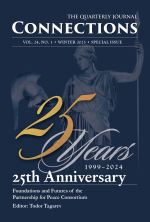This article provides a brief overview of the 25-year history of the Partnership for Peace Consortium of Defense Academies and Security Studies Institutes. It highlights the renewed international commitment to the Consortium and its principles, as observed during its 25th anniversary in 2024. Next, the article examines the Consortium through the Theory of Change concept, a logic modeling method for articulating how immediate actions link to long-term outcomes, particularly within complex systems. This approach analyzes the logical chain of events from the Consortium’s three strategic focus areas--intellectual interoperability, security sector cooperation, and institutional capacity building--to its desired strategic impacts, i.e., increasing regional stability, enhancing global security cooperation in order to address transnational security challenges, and fostering a more peaceful world that shares certain values including a commitment to democratic principles and the rules-based international order.
Reviewed article
A Theory of Change: 25 Years of the Partnership for Peace Consortium
Article statistics
Bibliography
“How Does AI Support Military Education, Training, Exercises and Evaluation,” Information Paper, PfP Consortium ADL Working Group, https://www.pfp-consortium.org/media/489/download.
Barrett, Jim, “Education for Reform: New Students, New Methods, New Assessments,” Connections: The Quarterly Journal 11, no. 4 (2012): 34-42, https://doi.org/10.11610/Connections.11.4.04.
Berry, John, “Defense Education Enhancement Program: The Consortium Perspective,” Connections: The Quarterly Journal 11, no. 4 (2012): 27-33, https://doi.org/10.11610/Connections.11.4.03.
Christman, Walter L., “The PfP Consortium ‘Community of Experts’ Approach to International Security Cooperation,” Connections: The Quarterly Journal 7, no. 3 (2008): 15-29, p. 15, https://doi.org/10.11610/Connections.07.3.02.
Costigan, Sean, Ernst Felberbauer, and Peter Foot, “The Challenges of Being Ten: Reflections on the Uniqueness of the PfP Consortium,” Connections: The Quarterly Journal 7, no. 3 (2008): 52-60, https://doi.org/10.11610/Connections.07.3.04.
d’Andurain, Jean, and Alan G. Stolberg, “Defense Education Enhancement Program: The NATO Functional Clearing-House on Defense Education,” Connections: The Quarterly Journal 11, no. 4 (2012): 53-58, https://doi.org/10.11610/Connections.11.4.06.
de Dardel, Jean-Jacques, “PfP, EAPC, and the PfP Consortium: Key Elements of the Euro-Atlantic Security Community,” Connections: The Quarterly Journal 7, no. 3 (2008): 1-14, https://doi.org/10.11610/Connections.07.3.01.
Ertmer, Peggy A., and Timothy J. Newby, “Behaviorism, Cognitivism, Constructivism: Comparing Critical Features from an Instructional Design Perspective,” Performance Improvement Quarterly 26, no. 2 (2013): 43-71, https://doi.org/10.1002/piq.21143.
Foot, Peter, “Taking Stock of the Consortium,” Connections: The Quarterly Journal 2, no. 2 (2003): 1-3, https://doi.org/10.11610/Connections.02.2.01.
Keagle, James M., “A Special Relationship: US and NATO Engagement with the Partnership for Peace to Build Partner Capacity Through Education,” Connections: The Quarterly Journal 11, no. 4 (2012): 59-74, https://doi.org/10.11610/Connections.11.4.07.
Keagle, James M., and Tiffany G. Petros, “Building Partner Capacity Through Education: NATO Engagement with the Partnership for Peace,” Connections: The Quarterly Journal 10, no. 1 (2010): 46-63, https://doi.org/10.11610/Connections.10.1.03.
Labarre, Frederic, “Whence and Whither the PfP Consortium?” Connections: The Quarterly Journal 7, no. 3 (2008): 70-74, https://doi.org/10.11610/Connections.07.3.06.
Perl, Raphael, and Enrico Mueller, “Partnership for Peace Consortium: An Innovative Approach to Defense Education and Institution Building,” in NATO: From Regional to Global Security Provider, ed. Yonah Alexander and Richard Prosen (Lexington Books, 2015), 209-219.
Perl, Raphael, ed., Annual Report 2018. PfP Consortium of Defense Academies and Security Studies Institutes (Vienna: PfP Counsortium and Austrian National Defence Academy, 2019), https://www.pfp-consortium.org/media/278/download.
Perl, Raphael, ed., Annual Report 2019. PfP Consortium of Defense Academies and Security Studies Institutes (Vienna: PfP Counsortium and Austrian National Defence Academy, 2020), https://www.pfp-consortium.org/media/361/download.
Perl, Raphael, ed., Annual Report 2020. PfP Consortium of Defense Academies and Security Studies Institutes (Vienna: PfP Counsortium and Austrian National Defence Academy, 2022), https://www.pfp-consortium.org/media/473/download.
Rickli, Jean-Marc, Federico Mantellassi, and Quentin Ladetto, “What, Why and When? A Review of the Key Issues in the Development and Deployment of Military Human‑Machine Teams,” Tailored Studies, Geneva Centre for Security Policy, February 7, 2024, https://www.gcsp.ch/publications/what-why-and-when-review-key-issues-development-and-deployment-military-human-machine.
Scoppio, Grazia, and Björn Lagerlöf, “The First Partnership for Peace Consortium Workshop on Women, Peace and Security in Professional Military Education: Reflections, Considerations, and the Way Ahead,” Canadian Military Journal 24, no. 1 (2024): 57-66, http://www.journal.forces.gc.ca/cmj-article-en-page57.html.
Stolberg, Alan G., Stuart Johnson, Laura Kupe, Building Partner-Nation Capacity Through the Defense Education Enhancement Program (Santa Monica, CA: RAND Corporation, 2018), https://www.rand.org/pubs/perspectives/PE286.html.
Vogel, Isabel, Review of the Use of ‘Theory of Change’ in International Development (London: UK Department for International Development, 2012).

